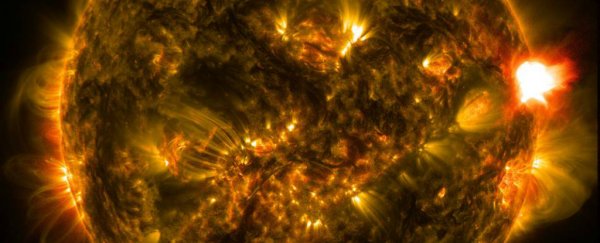New research suggests that, around 7,000 years ago, Earth was blasted with a period of solar activity so extreme, that traces of the event can still be seen in the carbon signature of tree rings today.
The mysterious 'solar event' has been dated back to 5480 BCE, and although it's unclear exactly what caused it, researchers say it involved an unprecedented shift in the Sun's magnetic activity. As far as they're aware, nothing like it has happened since in human history.
The Sun's activity regularly ebbs and flows along a roughly 11-year cycle, with the Sun becoming increasingly active and unleashing more solar storms and flares around halfway through the cycle, before dropping off again.
But 7,000 years ago, something else entirely happened.
The team found evidence of the mysterious 'solar event' while looking at the amount of the carbon-14 isotope in the rings of an ancient bristlecone pine tree from California, pictured below.
 A. J. Timothy Jull
A. J. Timothy Jull
These pines can live for thousands of years, and provide great insight into solar activity throughout their lifetime, because trees suck up atmospheric carbon and store it in rings each year of their lives.
So when solar activity is weak, the amount of carbon-14 in the atmosphere increases.
But when a team led by Nagoya University in Japan analysed this particular tree's rings, they saw uniquely high amounts of carbon-14 in the rings that they dated back to the year 5480 BCE, indicating a new type of solar event.
"We measured the carbon-14 levels in the pine sample at three different laboratories in Japan, the US, and Switzerland, to ensure the reliability of our results," said one of the researchers, A. J. Timothy Jull from the University of Arizona.
Looking across the tree ring record, the team only found two more other events that were similar - but less intense.
"We found a change in carbon-14 that was more abrupt than any found previously, except for cosmic ray events in 775 AD and 994 AD, and our use of annual data rather than data for each decade allowed us to pinpoint exactly when this occurred."
The newly identified event was the most dramatic by far.
What caused the strange solar activity in 5480 BCE is still unclear, but comparing it to the 775 and 994 AD events, the team thinks the carbon-14 pattern involved either a very weak Sun, or a series of repeated, strong solar flares.
"Although this newly discovered event is more dramatic than others found to date, comparisons of the carbon-14 data among them can help us to work out what happened to the sun at this time," said lead researcher Fusa Miyake from Nagoya University.
"We think that a change in the magnetic activity of the sun along with a series of strong solar bursts, or a very weak sun, may have caused the unusual tree ring data."
One of the tricky parts of trying to figure out the strange carbon-14 pattern is the fact that we still don't fully understand the mechanisms that drive solar activity, causing events such as potentially dangerous solar flares.
Now that the team has found evidence of the event, they're going to be using telescope studies of other Sun-like stars in the Universe to get an insight into what might have happened back in 5480 BCE.
The results could tell us more about how our Sun works, and how we can expect it to behave in future.
The research has been published in the Proceedings of the National Academy of Sciences.
